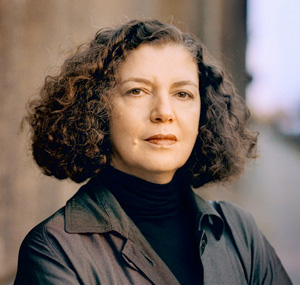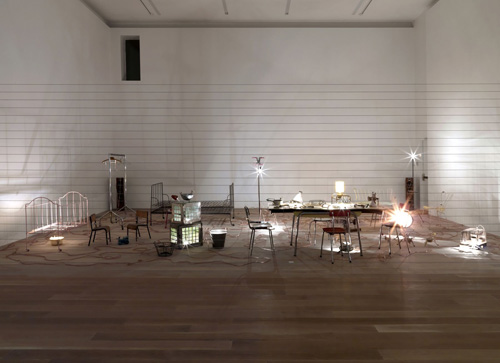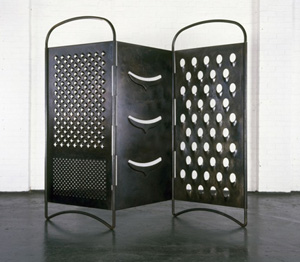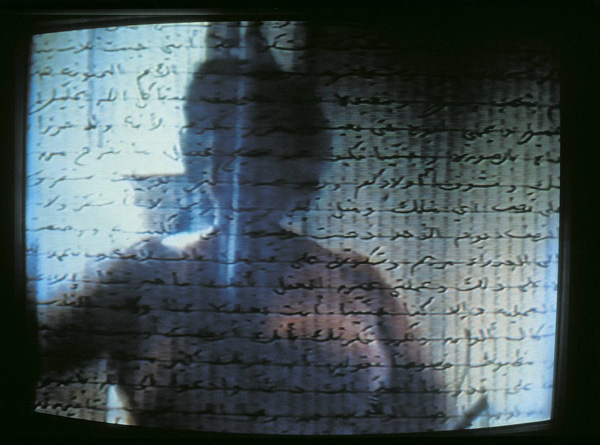
Mona Hatoum
The 2016 exhibition at London’s Tate Modern of the work of Mona Hatoum surprised and intrigued me. I knew little of her work before I saw this show, yet was sure it would be interesting and thought-provoking, as her life and ideas are of interest to me in my own work.
The artist’s biography is marked by exile: Hatoum is a British artist, born in 1952 into a Palestinian family exiled in Lebanon. For over three decades she has been creating works which ask us to re-consider how we see and understand the world, and its “notions of territory, fragility, humanity, scale and power” (Smith, 2016).

Mona Hatoum: Homebound 2000

Mona Hatoum: Hot Spot 2013
To say that Hatoum’s work is “electrifying” is perhaps a bit corny, given the literally electric component of much of her work, but I think it is completely apt. Indeed the electric current ran through Mona Hatoum’s whole show at Tate Modern. Ever present, like a now distant, now nearer threat, the crackle and droning hum could be heard almost everywhere, emitted from Homebound: furniture and objects arranged behind a barrier of taut steel wire.
Produced in 2000, this domestic arrangement of tables and chairs, kitchen utensils, lights, cots, toys, a birdcage, are all wired-up so that an audible current surges round the room, with objects lit up in turn, “the aggressive sound amplified for our pleasure and disquiet. With Hatoum, the two are almost always twinned.” (Searle, 2016)

Mona Hatoum: Grater Divide 2002
Homebound is just one of several “anxious interiors” in an exhibition that shows Hatoum’s oeuvre. Her 2013 piece Hot Spot presents the entire globe as a danger zone, with the term ‘hot spot’ referring to a place of “military or civil unrest”; here red neon outlines the contours of the world’s continents, showing what Hatoum describes as a “world continually caught up in conflict and unrest”(Smith, 2016).
Much of her work is darkly disturbing when you may think it will be at first glance. The over-sized, scaled-up domestic appliances of Grater Divide and Dormiente, using items such as graters and other kitchen utensils, useful and homely at their regular size, take on sinister characters hinting at torture implements when larger than human-scale.

Mona Hatoum: Dormiente 2008

Mona Hatoum: Dormiente (detail) 2008
A key piece for me is Mona Hatoum’s film Measures of Distance. It speaks to me of the inter-connectedness of familial relationships across space and time. In the film, the artist’s mother is shown in close-up, in the intimacy of her shower. Fragments of Arabic script from their handwritten correspondence form a visual barrier over the image; like barbed wire, the script conceals and reveals the body speaking simultaneously of literal and implied closeness and distance, simultaneously expressing the painful distance of displacement and the longings for closeness that mark the artist’s experience.

Mona Hatoum: Measures of Distance 1988 (film still)
In this work I was also trying to go against the fixed identity that is usually implied in the stereotype of Arab woman as passive, mother as non-sexual being the work is constructed visually in such a way that every frame speaks of literal closeness and implied distance.
(Quoted in Mona Hatoum 1997, p.140).

Mona Hatoum: Measures of Distance 1988 (film still)
The film graphically highlights the difficulties of communicating across the geographical divide: Hatoum’s audio track reading of the letters in both Arabic and English shows the dual identity through language that a migrant or exile experiences and takes on board: language both expands and limits expression, here the dual language also serves to bring audiences of both languages closer together.
Exploring themes of home and displacement from the perspective of the Palestinian exile, Mona Hatoum’s works, from the last thirty years and today, continue to be relevant in this “age of migrants, curfews, identity cards, refugees, exiles, massacres, camps and fleeing civilians” (Said, 2000).
Further reading
- Archer, M. and Brett, G. (1997) Mona Hatoum. London, England: Phaidon Press.
- Artnet: Mona Hatoum (no date)
- Demos, T. J, (2013) The migrant image: the art and politics of documentary during global crisis. Durham, North Carolina: Duke University Press.
- Manchester, E. (2000) Mona Hatoum: Measures of Distance 1988
- Tate: Mona Hatoum
- Tate: Who is Mona Hatoum?
- Said, E.W. (2000) “The Art of Displacement: Mona Hatoum’s Logic of Irreconcilables” in Mona Hatoum: The Entire World as a Foreign Land. London: Tate. [Exhibition catalogue].
- Said, E.W. (1994) Culture And Imperialism. New Edition, London: Vintage.
- Said, E.W. (2003) Orientalism. London: Penguin.
- Said, E.W. (1999, 2013) Out of Place: A Memoir. Kindle Edition, London: Granta.
- Said, E.W. (2001, 2012) Reflections on exile: and other essays. Rev. edn. London: Granta.
- Said, E.W. (1983, 1991) The world, the text, and the critic. Rev. edn. London: Vintage.
- Searle, A. (2016) Mona Hatoum review – electrified, if not always electrifying from the Guardian
- Smith, A. (2016) Never take anything for what it appears to be from Tate Etc. issue 37: Summer 2016
- Van Assche, C. and Wallis C. (2015) Mona Hatoum. Reprint. London, England: Tate Publishing, 2010.
- White Cube (2006) Mona Hatoum – Hot Spot
Gallery websites featuring the artist’s work

One thought on “Mona Hatoum’s “Measures of Distance” is a reflection of our global life”